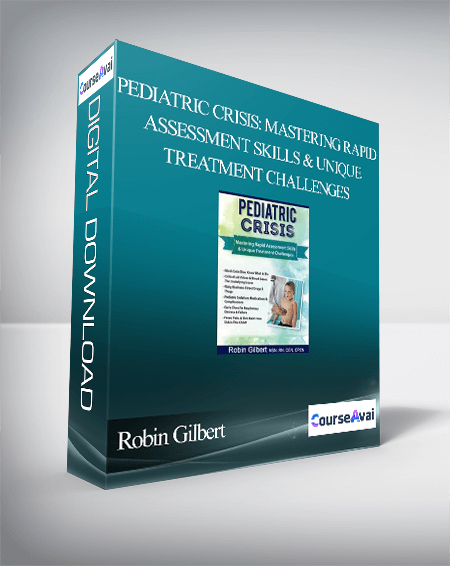$200.00 Original price was: $200.00.$66.00Current price is: $66.00.
You are caring for a child who presents with severe dyspnea, stridor, retractions, and cyanosis following a snack at daycare. On the monitor, the child’s heartrate is decreasing and oxygen saturations are dropping.
 Purchase this course you will earn 66 Points worth of $6.60
Purchase this course you will earn 66 Points worth of $6.60Elevate your skills with the Pediatric Crisis: Mastering Rapid Assessment Skills & Unique Treatment Challenges – Robin Gilbert course, available for just $200.00 Original price was: $200.00.$66.00Current price is: $66.00. on Utralist.com! Browse our curated selection of over 60,000 downloadable digital courses across diverse Health and Medical. Benefit from expert-led, self-paced instruction and save over 80%. Start learning smarter today!
You are caring for a child who presents with severe dyspnea, stridor, retractions, and cyanosis following a snack at daycare. On the monitor, the child’s heartrate is decreasing and oxygen saturations are dropping.
Purchase Pediatric Crisis: Mastering Rapid Assessment Skills & Unique Treatment Challenges – Robin Gilbert courses at here with PRICE $200 $66
DOWNLOAD INSTANTLY
PLEASE CHECK ALL CONTENTS OF THE COURSE BELOW!

 Pediatric Crisis: Mastering Rapid Assessment Skills & Unique Treatment Challenges – Robin Gilbert
Pediatric Crisis: Mastering Rapid Assessment Skills & Unique Treatment Challenges – Robin Gilbert
- Mock Code Blue: Know What to Do
- Critical Lab Values & Blood Gases: The Underlying Issues
- Risky Business: Street Drugs & Thugs
- Pediatric Sedation: Medications & Complications
- Early Clues for Respiratory Distress & Failure
- Fever, Pain, & Skin Rash: How Sick is This Child?
You are caring for a child who presents with severe dyspnea, stridor, retractions, and cyanosis following a snack at daycare. On the monitor, the child’s heartrate is decreasing and oxygen saturations are dropping. His mental status is quickly deteriorating. The physician chooses to intubate. What size ET tube do you anticipate for this child? IV access is not obtainable and the decision is made to start an Intraosseous (IO). You are not sure if you have an IO on your code cart – and you have never used one. The physician orders epinephrine 0.01mg/kg IO. Epinephrine is given, the child develops ventricular tachycardia. Now what…?
This high-anxiety situation just became your worst nightmare. Nothing increases YOUR heartrate more than the pediatric patient who suddenly decompensates. What are your biggest concerns: Calculating the medication dose in a code situation? Managing the airway? Missing the subtle signs that lead to the need for a rapid response? Children have unique differences that require additional assessment skills and interventions. Become confident in your assessment skills and be prepared to handle emergent situations. You will have time to practice mock rapid response scenarios, use Broselow tape, calculate/draw up medications, and review airway management tools. Robin Gilbert, MSN, RN, CEN, CPEN, will teach you strategies to recognize and stabilize life-threatening emergencies that take place in the pediatric population.
- Analyze case scenarios to determine acuity and prioritization.
- Differentiate between common rashes and those that require immediate intervention.
- Interpret lab values and quickly identify potential causes of abnormal values.
- Determine the unique pediatric needs during presentation of respiratory distress or failure.
- Assess for causes of neurological deterioration in pediatric patients.
- Perform sample medication calculations.
- Discuss nursing responsibilities during the use of moderate sedation.
- Differentiate between clinical characteristics of acute abdominal diagnoses.
Abdominal Pain: Appendicitis and Beyond
- Gastorenteritis
- Intussusception/Volvulus
- Pyloric stenosis
- Testicular torsion/Epididymitis
- Diaphragmatic hernia
- Gastroschisis
The Pediatric Airway
- Recognizing the child in distress
- Unique characteristics of the pediatric airway
- Urgent respiratory conditions
- Tracheoesophageal fistula
- Asthma
- RSV / Bronchiolitis
- Cystic Fibrosis
- Chest Trauma
ALTE vs. BRUE
- Clinical manifestations
- Management
Risky Business: Street Drugs, Tattoos and More
- What’s trending
- Amphetamines
- Cocaine
- K2, Spice, Molly
- Implications & interventions
Fever in the Neonate
- Sepsis workup & when?
- Antibiotics for neonate vs. infant
Head Injuries
- ICP assessment
- Skull fractures
- Concussion/Contusion/TBI
Bruises & Fractures
- Does the story fit – or is it maltreatment?
When a Rash Becomes a Risk
- Varicella
- Measles & More
Lab Values & Blood Gases
- What impacts the numbers: Identifying potential causes
- Blood gases simplified
- Blood glucose, DKA, & insulin protocols
Hematologic & Coagulation Disorders
- Sickle cell anemia
- Hemophilia
Procedural Sedation
- Medications and equipment
- The nurse’s responsibilities
- Prevention and management of complications
Pediatric Code Blue: Know What to Do
- A, B, Cs
- Arrhythmias
- Med calculations
Purchase Pediatric Crisis: Mastering Rapid Assessment Skills & Unique Treatment Challenges – Robin Gilbert courses at here with PRICE $200 $66
Cultivate continuous growth with the Pediatric Crisis: Mastering Rapid Assessment Skills & Unique Treatment Challenges – Robin Gilbert course at Utralist.com! Unlock lifetime access to premium digital content, meticulously designed for both career advancement and personal enrichment.
- Lifetime Access: Enjoy limitless access to your purchased courses.
- Exceptional Value: Benefit from savings up to 80% on high-quality courses.
- Secure Transactions: Your payments are always safe and protected.
- Practical Application: Gain real-world skills applicable to your goals.
- Instant Accessibility: Begin your learning journey immediately after buying.
- Device Compatible: Access your courses seamlessly on any device.
Transform your potential with Utralist.com!
Related products
Health and Medical
= 53 Points
Health and Medical
= 18 Points
Health and Medical
= 53 Points
Health and Medical
“Male Physique Training Templates” – Renaissance Periodization
= 42 Points
Health and Medical
Train Your Mind for Athletic Success – Mental Preparation to Achieve Your Sports Goals – Jim Taylor
= 18 Points
Health and Medical
= 74 Points
Health and Medical
= 72 Points
Health and Medical
= 33 Points




 Pediatric Crisis: Mastering Rapid Assessment Skills & Unique Treatment Challenges – Robin Gilbert
Pediatric Crisis: Mastering Rapid Assessment Skills & Unique Treatment Challenges – Robin Gilbert






